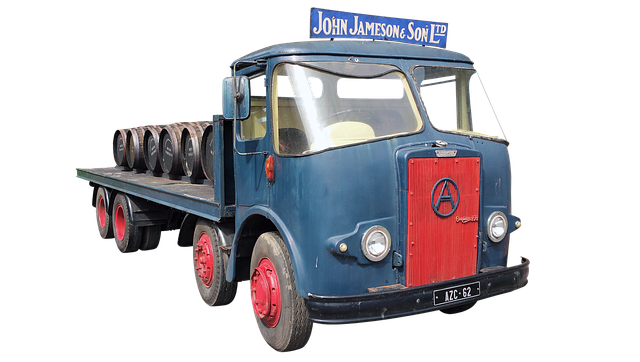Looking to register your car in California? This comprehensive guide walks you through every step, from understanding key requirements to completing crucial VIN verification. Gather essential documents, perform a vehicle identification number (VIN) check, and either submit your application online or visit a DMV office. Once approved, pay fees and receive your new plates. Simplify the process with these clear instructions, ensuring a smooth ride ahead.
- Understand California Car Registration Requirements
- Gather Necessary Documents for VIN Verification
- Perform Vehicle Identification Number (VIN) Check
- Complete Online Registration or Visit DMV Office
- Pay Registration Fees and Receive Your Plate
Understand California Car Registration Requirements

Before registering your car in California, it’s crucial to understand the state’s specific requirements for vehicle identification number (VIN) verification. California law mandates that all vehicles operated within the state must undergo a thorough inspection to ensure they meet safety and emissions standards. This process involves verifying the VIN, which is a unique identifier for your car, to confirm its authenticity and history.
A key component of this verification is often handled by professional mobile vin verifiers or vin inspectors who can perform the check on-site, saving you time and effort. These specialists use specialized equipment to cross-reference the VIN against databases, uncovering crucial information about the vehicle’s past, including accident history, outstanding loans, and recall notifications. This comprehensive vin inspection is an essential step in ensuring compliance with California car registration regulations.
Gather Necessary Documents for VIN Verification

Before registering your car in California, you’ll need to gather several crucial documents for the VIN (Vehicle Identification Number) verification process. This step is essential for ensuring that your vehicle meets all legal requirements and safety standards. For a smooth registration experience, prepare the following:
1. A valid driver’s license or state-issued ID card.
2. The vehicle’s title, if applicable, showing your name and current ownership.
3. Proof of insurance, demonstrating that your car is covered under a valid policy.
4. A completed California Vehicle Registration Application (DMV Form 140).
5. Documents related to any previous registrations or titles, if applicable.
6. The vehicle’s VIN, which can typically be found on the dashboard near the driver’s side door or in the engine compartment. For a convenient alternative, consider using a mobile VIN verification service that allows you to complete this step digitally.
Perform Vehicle Identification Number (VIN) Check

Before you start the registration process, it’s crucial to perform a Vehicle Identification Number (VIN) check. This step is essential for ensuring that the car you’re planning to register is legitimate and hasn’t been reported stolen or had its identity tampered with. A mobile vin verifier or even a simple vin inspection can verify the vehicle’s history, including its previous owners and any accidents or significant damage.
In California, this verification process is an integral part of the registration procedure. You’ll need to provide proof of a successful VIN verification as one of the required documents when submitting your registration application. A mobile vin inspection service can make this task convenient by allowing you to complete this step from the comfort of your home or even while you’re on the go, ensuring a smoother car registration experience in the Golden State.
Complete Online Registration or Visit DMV Office

You have two options for registering your car in California: complete the process entirely online or visit a DMV office in person. If you choose to go digital, start by visiting the California DMV website and accessing their online registration portal. Here, you’ll need to provide essential details about your vehicle, including its make, model, year, and the current odometer reading. You’ll also be required to enter your personal information and payment details for the registration fee. One key step is the vin verification process; ensure you have your Vehicle Identification Number (VIN) ready as it needs to be accurately entered for a successful online registration.
If you prefer a more traditional approach or face issues with the online method, head over to your nearest DMV office. Bring along your necessary documents, including proof of ownership, identification, and insurance. A staff member will guide you through the registration process, which may include a vin inspection to validate the vehicle’s information. Alternatively, some services offer mobile vin verification, bringing the convenience of vehicle registration directly to your location.
Pay Registration Fees and Receive Your Plate

After completing the registration application process, it’s time to pay the required fees for car registration in California. The costs involved include a base fee, vehicle emissions inspection fee, and potentially other taxes or surcharges depending on your vehicle type. You can typically pay online, by mail, or in person at a DMV office. Once your payment is processed, the California Department of Motor Vehicles (DMV) will issue your vehicle’s license plate.
Ensure that you have passed the vin verification process before proceeding. A mobile vin verifier or inspector can facilitate this step by remotely checking the vehicle identification number (VIN) against the DMV database to ensure the car matches the reported information and has no outstanding issues. After receiving your plates, display them prominently on your vehicle as required by California law for optimal visibility during driving.
Registering a car in California involves understanding state requirements, gathering essential documents for VIN verification, completing an online registration or visiting a DMV office, and paying associated fees. This process ensures your vehicle complies with local regulations, enabling you to legally operate it on California roads. Remember, a meticulous VIN check is crucial for a smooth registration experience.
